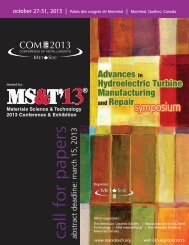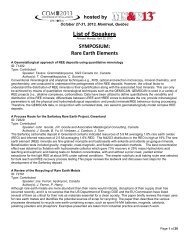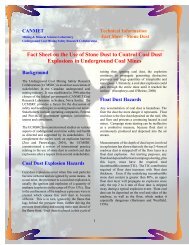List of Speakers SYMPOSIUM: Light Metals for Transportation
List of Speakers SYMPOSIUM: Light Metals for Transportation
List of Speakers SYMPOSIUM: Light Metals for Transportation
Create successful ePaper yourself
Turn your PDF publications into a flip-book with our unique Google optimized e-Paper software.
hosted byOctober 27-31, 2013, Montreal, Quebec<strong>List</strong> <strong>of</strong> <strong>Speakers</strong>Revised: Monday, April 22, 2013<strong>SYMPOSIUM</strong>:<strong>Light</strong> <strong>Metals</strong> <strong>for</strong> <strong>Transportation</strong>3D Meso-scale Modelling <strong>of</strong> Aluminum-alloy Welding Processes <strong>for</strong> Prediction <strong>of</strong> Hot Crack FormationID: 71346Type: ContributedSpeaker: Hamid Reza Zareie Rajani, University <strong>of</strong> British Columbia, CanadaAuthor(s): H. Zareie Rajani, A. PhillionMeso-scale modeling through the granular models is a key new tool <strong>for</strong> predicting solidification-related defects. In thepresent study, a granular model <strong>of</strong> solidification has been developed to simulate the weldingprocess as a first steptowards predicting solidification cracking. Although the translation <strong>of</strong> the granular modeling methodology from anequiaxed-globular microstructure to the welding microstructure introduces new challenges, this study shows thesuccessful application <strong>of</strong> this model in welding. By means <strong>of</strong> the developed 3-D meso-scale model, the susceptibility <strong>of</strong>the weld to hot crack could be discussed. The permeability <strong>of</strong> liquid channels at the last stages <strong>of</strong> solidification has beenstudied as a susceptibility criterion. Moreover, the effect <strong>of</strong> different welding parameters, cooling rate and the size <strong>of</strong>grains on this criterion hasbeen investigated to find out how welding parameters can change the risk <strong>of</strong> hot cracking inwelding <strong>of</strong> aluminum alloys.Alpha Case Thickness: A Comparative Study <strong>of</strong> Evaluation Techniques and the Relation Between ThemID: 72516Type: ContributedSpeaker: Alexandre Bois-Brochu, Centre de Métallurgie du Québec, CanadaAuthor(s): A. Bois-Brochu, M. C. Parr, G. Morin, J. Carignan, G. MarinThe presence <strong>of</strong> an alpha case on titanium parts produced by investment casting is problematic and has to be eliminated.The evaluation <strong>of</strong> the thickness to be removed can be done using different techniques such as metallographicmeasurements, micro-hardness pr<strong>of</strong>iles and energy dispersive x-ray spectroscopy linescans. Those three techniquesmeasure different characteristics <strong>of</strong> the alpha case. However, a part analyzed with one technique will not give the samealpha case thickness evaluation as another method <strong>of</strong> evaluation. The first goal <strong>of</strong> this study was to evaluate how thethree methods are related locally, by using micro-hardness pr<strong>of</strong>iles and comparing them with EDS linescanmeasurements and metallographic evaluations at specific locations. The second purpose was to quantify the correlationbetween the methods by using a statistical practice. For this analysis, the mean values <strong>of</strong> twenty metallographicmeasurements, three micro-hardness and multiple EDS linescans were used.Analysis <strong>of</strong> Topic Distributions in Canadian Metallurgical Quarterly (CMQ) 1961-2010ID: 71518Type: StudentPosterSpeaker: Nicholas Kilingi, Concordia University, CanadaAuthor(s): N. Kilingi, H. McQueenTo develop an insight into Metallurgical Society CIM activities during the past half century, an analysis was undertaken <strong>of</strong>subjects published in the CMQ. The subjects were classified into some 40 different topics and presented in tables at 5year intervals. The significant groups started from properties with divisions <strong>for</strong> microstructural, physical, thermo dynamicand mechanical; the last has more details <strong>for</strong> hot workability, such as Al alloys, C/HSLA and tool steels, stainless steels,Cu and Ni alloys, and hexagonal metals. Secondary processing includes hot working, cold working / annealing, casting,welding, and heat treatment. Extractive metallurgy includes steel making, smelting / non-ferrous, hydro-metallurgy andmineral dressing / flotation. There are headings also <strong>for</strong> environment, energy and history as well as ceramics, polymersand semi-conductors. The techniques employed and the approximations to achieve this analysis are described.Page 1 <strong>of</strong> 17
hosted byOctober 27-31, 2013, Montreal, Quebec<strong>List</strong> <strong>of</strong> <strong>Speakers</strong>Revised: Monday, April 22, 2013<strong>SYMPOSIUM</strong>:<strong>Light</strong> <strong>Metals</strong> <strong>for</strong> <strong>Transportation</strong>Canadian Metallurgical Quarterly (CMQ):Topic Distributions In The First 50 Years 1961-2011ID: 71190Type: ContributedSpeaker: Hugh McQueen, Concordia University, CanadaAuthor(s): H. McQueen, N. KilingiFor insight into Metallurgical Society CIM activities during the past half century, the subjects published in the CMQ wereclassified into 40 topics as presented in tables at 5 year intervals; graphs compare the relative changes over the years.Hot workability <strong>of</strong> Al alloys is charted in comparison to Mg alloys and steels. The significant groups started from propertieswith divisions <strong>for</strong> microstructural, physical, thermo dynamic and mechanical; the last has more details <strong>for</strong> hot workability(author’s specialty): Al alloys, C/HSLA, tool, stainless steels, Cu and Ni alloys, and hexagonal metals. Secondaryprocessing includes hot working, cold working / annealing, casting, welding, and heat treatment. Extractive metallurgyincludes steel making, smelting / non-ferrous, hydro-metallurgy and mineral dressing / flotation. There are headings als<strong>of</strong>or environment, energy and history as well as ceramics, polymers and semi-conductors. For hot working, there is somediscussion <strong>of</strong> Met. Soc. Proceedings, especially <strong>Light</strong> <strong>Metals</strong> volumesCharacterisation <strong>of</strong> the Creep Behaviour <strong>of</strong> the Cathode Steel Bar Connector at High Temperatures and LowStress LevelsID: 72366Type: ContributedSpeaker: Femi Fakoya, REGAL, Universite Laval, CanadaAuthor(s): F. Fakoya, D. Picard, H. Alamdari, M. FafardMechanical properties <strong>of</strong> carbon steel at high temperatures, low stress levels are important and their per<strong>for</strong>mance inapplications such as aluminium production cell, power plants and nuclear reactor plants are still not well understood.Hence, an experimental program was carried out to investigate the mechanical properties <strong>of</strong> carbon steel in thisaggressive environment. The mechanical properties <strong>of</strong> carbon steel in austenite temperature region and particularly lowstress levels have been investigated in relation to its creep behaviour in compression with an eye towardscharacterisation. The mechanical properties were obtained under a steady state compression test at ambient and hightemperatures up to 950oC. The time dependent mechanical properties were also obtained usingcompression creep tests at constant low stresses (0.5 – 1 MPa) and constant high temperatures (800–950oC). A stress required to activate creep at high temperature was identified and minimum temperaturerequired <strong>for</strong> activating creep de<strong>for</strong>mation was also determined.Characterization <strong>of</strong> Fir-Tree Zones in AA1050 DC Cast IngotID: 71822Type: ContributedSpeaker: Zhan Zhang, University <strong>of</strong> Quebec at Chicoutimi, CanadaAuthor(s): Z. Zhang, G. Li, X. ChenFir-tree zones, caused by transition <strong>of</strong> various Fe-bearing intermetallics in cast microstructure, are one <strong>of</strong> mostencountered defects in aluminum direct chill (DC) cast ingots, which could result in serious surface problems <strong>for</strong> highquality surface appearance products. However, the <strong>for</strong>mation mechanism <strong>of</strong> fir-tree zones has not been well understoodbecause <strong>of</strong> great challenges on identification and quantification <strong>of</strong> the Fe-bearing intermetallics. Using combination <strong>of</strong>electron backscattered diffraction, energy dispersive spectrum and image analysis techniques, the transition <strong>of</strong> Fe-bearingintermetallics throughout the fir-tree zones <strong>of</strong> AA1050 DC ingot were quantitatively investigated. It was found that severalintermetallics such as AlmFe, a-AlFeSi, Al6Fe, Al3Fe and Ni-containing (AlFeNi) phases co-existed in the zones. Typicalintermetallics morphology in the zones was revealed using deep-etching technique. The volume fraction and distributionPage 2 <strong>of</strong> 17
hosted byOctober 27-31, 2013, Montreal, Quebec<strong>List</strong> <strong>of</strong> <strong>Speakers</strong>Revised: Monday, April 22, 2013<strong>SYMPOSIUM</strong>:<strong>Light</strong> <strong>Metals</strong> <strong>for</strong> <strong>Transportation</strong><strong>of</strong> Fe-bearing intermetallics over the fir-tree zones were quantified. The mechanism and causes <strong>of</strong> the fir-tree zones inDC cast ingot were discussed.Cold Sprayed Stainless Steel Coatings <strong>for</strong> Wear and Thermal Protection <strong>of</strong> AluminumID: 71281Type: ContributedSpeaker: Dominique Poirier, National Research Council <strong>of</strong> Canada, CanadaAuthor(s): D. Poirier, E. Irissou, D. Gallant, J. Jiang, J. LegouxReplacing steel by aluminum in vehicles components can reduce their weight by almost half, resulting in remarkable fuelsavings and gas emission reductions. Because aluminum exhibits poor wear and lower temperature resistance comparedto the current iron parts, there is a rising interest in shielding aluminum parts with protective coatings to alleviate thoseissues. Cold spray (CS) is a process in which non-molten powder particles are propelled by a supersonic gas jet andsprayed onto a substrate where they plastically de<strong>for</strong>m to generate a coating. In this study, stainless steel coatings <strong>of</strong>varying compositions were deposited by CS on aluminum substrates using powders displaying different morphologies.Coatings were characterized by SEM and their wear, corrosion and thermal cycling resistances were evaluated. It wasfound that adherent and dense stainless steel coatings display better wear resistance than bulk stainless steel, along witha high resistance to the development <strong>of</strong> blistering corrosion.Continuous Casting and Product Characterization <strong>of</strong> Al-Mg-Sc-Zr Alloys Strips Produced via Horizontal SingleBelt Casting (HSBC)ID: 73242Type: ContributedSpeaker: Mert Celikin, McGill University, CanadaAuthor(s): M. Celikin, S. Ge, D. Sediako, M. Isac, R. GuthrieThe combined additions <strong>of</strong> Scandium (Sc) and Zirconium (Zr) to Al-Mg binary alloys have proven to be effective inproviding strength, enhanced elevated temperature resistance and improved workability at room temperature. Theseimprovements have lead quaternary Al-Mg-Sc-Zr alloys to be important candidates <strong>for</strong> aerospace applications, <strong>for</strong> airframes and stiffened panels. The main processing route <strong>for</strong> these alloys involves direct chill (DC) casting, followed bythermo-mechanical treatment (homogenization, hot and cold rolling). In the present work, strips <strong>of</strong> Al-Mg-Sc-Zr alloyswere produced via Horizontal Single Belt Strip Casting (HSBC) technology, and were subsequently characterized usingOptical microscopy, SEM-EDS and EBSD, 3D Pr<strong>of</strong>ilometry. Additionally, mechanical properties such as hardness, andtensile testing were per<strong>for</strong>med. Thermodynamic and kinetic studies on the <strong>for</strong>mation <strong>of</strong> Al3(Scx,Zr1-x) phase during alloyprocessing and solidification were carried out, using High Temperature Laser Confocal Microscopy, and in-situ neutrondiffraction.Deep Drawing <strong>of</strong> Aluminum; J.W. Lengdridge (Alcan 1948-49, The Tool Engineer)ID: 71205Type: ContributedSpeaker: Hugh McQueen, Concordia University, CanadaAuthor(s): H. McQueenThe drawing <strong>of</strong> cups along with related blanking and piercing were clearly described and illustrated in a 14-article series inthe Tool Engineer, 1948-49. The elegant, explanatory diagrams need to be exhibited in commemoration <strong>of</strong> J.W.Lengdridge. In deep drawing a circular cup from a flat sheet, a narrow rectangle <strong>of</strong> the sidewall is produced from atriangular segment <strong>of</strong> the original blank (excepting the bottom) that has been compressed circumferentially whilelengthening and thickening more near the top. The control <strong>of</strong> the wrinkle-preventing die-face hold-down pressures andPage 3 <strong>of</strong> 17
hosted byOctober 27-31, 2013, Montreal, Quebec<strong>List</strong> <strong>of</strong> <strong>Speakers</strong>Revised: Monday, April 22, 2013<strong>SYMPOSIUM</strong>:<strong>Light</strong> <strong>Metals</strong> <strong>for</strong> <strong>Transportation</strong>punch-die clearances, lubrication, blank dimensions and shapes <strong>for</strong> both circular pots and rectangular boxes areillustrated. The pioneering multiple draws <strong>for</strong> very deep cylinders combined with sidewall ironing has made possiblebeverage cans. The problem <strong>of</strong> earring in anisotropic sheet and the development <strong>of</strong> hot rolling schedules <strong>for</strong> isotropic stripis explained. History is traced to iron frying pans and armor.Design <strong>of</strong> Precipitation Strengthened Al-Sc-Zr-X Alloys Characterized by High-Temperature HardnessID: 73370Type: StudentSpeaker: Matthew Wong, Michigan Technological University, USAAuthor(s): M. Wong, P. SandersPrecipitation hardening <strong>for</strong> high-temperature applications can be achieved through the addition <strong>of</strong> small amounts <strong>of</strong>scandium and zirconium to nearly-pure aluminum. Designed “mixture” experiments using thermodynamic databases wereutilized to optimize precipitation hardening in Al-Sc-Zr alloy systems through the additions <strong>of</strong> a fourth alloying element.The strategy was to increase the age hardening response by optimizing the solvus line bordering the single-phase alphaaluminumregion. Samples prepared by arc-melting and isochronal aging were characterized by high-temperaturehardness to quantify precipitation strengthening. Exploration <strong>of</strong> new low-alloy aluminum systems may introduce improvedhigh-temperature properties and lead to improvements in thermodynamic databases related to Al-Sc-Zr-X alloy systems.Development <strong>of</strong> Steel/Mg Alloy Multilayered Composite by Reactive Transient Liquid Phase Bonding MethodID: 72573Type: ContributedSpeaker: Shoichi Nambu, The University <strong>of</strong> Tokyo, JapanAuthor(s): S. Nambu, N. Kyokuta, M. Ojima, J. Inoue, T. KosekiA multilayered composite consisting <strong>of</strong> ductile steel and Mg alloy was developed in order to achieve novel structuralmaterials having higher specific strength and ductility combination. To produce the composite, the authors developed anew bonding method called reactive transient liquid phase (r-TLP) bonding method, which uses an eutectic melt <strong>of</strong> Mg-Ag<strong>for</strong> TLP process and enables to produce a very thin and uni<strong>for</strong>m intermetallic compound layer at interface between steeland Mg alloy through the melt. High bonding strength above the yield strength <strong>of</strong> Mg alloy was obtained by the r-TLPbonding method. Furthermore, multilayered composite <strong>of</strong> AISI304 stainless steel and AZ31 Mg alloy was fabricated usingthe r-TLP bonding, and was found to have improved specific strength and ductility combination above 4000 kNm%/kg.Different Effects <strong>of</strong> Neodymium and Strontium on the High Temperature Oxidation and Ignition Resistance <strong>of</strong>Pure MagnesiumID: 72661Type: ContributedSpeaker: Deniz Aydin, McGill University, CanadaAuthor(s): D. Aydin, M. PekguleryuzThe high temperature oxidation and ignition behavior <strong>of</strong> binary Mg-Nd and Mg-Sr alloys were investigated. Differenteffects <strong>of</strong> Nd and Sr were observed via continuous heating experiments carried out in dry air-flow. The ignitiontemperature (Ti) increased with increasing Sr from 640 oC (<strong>of</strong> pure Mg) to up to 854 oC at 6 wt% Sr. The change in Tiwas related to the surface segregation <strong>of</strong> Sr and to the activity <strong>of</strong> the elements in the surface in the pre-ignition stage. Nd,on the other hand, increased the ignition temperature to only 770 oC at 0.5 wt% Nd with higher amounts <strong>of</strong> Nd notproducing further increase in Ti. It has been found that the <strong>for</strong>mation <strong>of</strong> compact MgO-Nd2O3 surface scale on Mg-Ndalloys increases the oxidation and ignition resistance <strong>of</strong> pure Mg but the surface scale degrades in prolonged exposure.Page 4 <strong>of</strong> 17
hosted byOctober 27-31, 2013, Montreal, Quebec<strong>List</strong> <strong>of</strong> <strong>Speakers</strong>Revised: Monday, April 22, 2013<strong>SYMPOSIUM</strong>:<strong>Light</strong> <strong>Metals</strong> <strong>for</strong> <strong>Transportation</strong>Effect <strong>of</strong> Iron and Sr in the evolution <strong>of</strong> Iron based intermetallic Phases in Al-Si hypoeutectic alloysID: 72811Type: ContributedSpeaker: Sumanth Shankar, McMaster University, CanadaAuthor(s): A. Gorny, J. Manickaraj, S. ShankarThe main aim <strong>of</strong> the study is to understand the <strong>for</strong>mation <strong>of</strong> the iron bearing intermetallic phases and the effect <strong>of</strong> Sraddition on them in the Al-Si hypoeutectic alloys. This study has methodically characterized the iron based intermetallicphases evolving during solidification <strong>of</strong> the Al-7 wt%Si binary alloy as a function <strong>of</strong> composition <strong>of</strong> Fe (0.1,0.2, 0.35,0.5and 0.8 wt%), Sr (0 and 200 ppm) and cooling rates (0.1, 1 and 50 K/s). The samples were analyzed by using the thermaldata obtained during solidification and various microscopy techniques. The Al-Si-Fe intermetallic phase compositionswere analyzed by Energy Dispersive X-Ray Spectrometer (EDX) and it was observed that there is anomalous evolution <strong>of</strong>certain Al-Si-Fe intermetallic phases in both alloys with and without Sr addition. The phases evolving in alloys without Sris different from that with Sr in them.Effect <strong>of</strong> Texture on Precipitation Kinetics in Aluminum AlloysID: 72373Type: ContributedSpeaker: Kaustubh Kulkarni, IIT Kanpur, IndiaAuthor(s): S. Mishra, N. Gurao, S. Shekhar, K. KulkarniControlling the orientation <strong>of</strong> precipitates can potentially improve the strength <strong>of</strong> an alloy in a desired direction.Development <strong>of</strong> texture through thermomechanical processing can affect the nucleation and growth kinetics <strong>of</strong>semicoherent precipitates that cause age hardening in aluminium alloys. In order to understand the effect <strong>of</strong> texture onage hardening kinetics, wrought aluminium alloys were thermo-mechanically processed to develop various types <strong>of</strong>textures in the alloys. The age hardening treatments are carried out on these alloys at different temperatures and times.Tensile tests were carried out on specimens drawn in different directions with respect to the rolling direction to estimatethe evolution <strong>of</strong> anisotropy in mechanical properties. A detailed analysis <strong>of</strong> microstructure as well as bulk and microtexture was carried out to establish a relationship between crystallographic texture and precipitation kinetics. This study isexpected to enable development <strong>of</strong> processing pathways <strong>for</strong> controlling the strength <strong>of</strong> age-hardened alloys in specificdirections.Elevated Temperature Wedge Compression Testing <strong>of</strong> Precipitation Hardenable Al-Sc-Zr AlloysID: 71649Type: StudentSpeaker: Cameron McNamara, Michigan Technological University, USAAuthor(s): C. McNamara, S. Kampe, P. Sanders, D. SwensonEfficient precipitation strengthening and kinetic stability can be obtained in nearly-pure aluminum through the combinedaddition <strong>of</strong> fractional percentages <strong>of</strong> scandium and zirconium. The trialuminide precipitation sequence in these alloys canbe tailored through de<strong>for</strong>mation processing and artificial aging. This work utilizes wedge-shaped compression samples <strong>of</strong>cast Al-Sc-Zr as a means to produce a continuous plastic strain gradient to examine the role <strong>of</strong> de<strong>for</strong>mation onmicrostructural evolution. The samples exhibit a radial distribution <strong>of</strong> plastic strain, and will be compressed at elevatedtemperatures to facilitate in-situ precipitation. Strengthening is quantified via microhardness mapping and microstructuralobservations; these data will be correlated with a finite element analysis (FEA) <strong>of</strong> the strain distribution. Thisexperimentation is per<strong>for</strong>med as an analog to controlled rolling, a method <strong>of</strong> reducing cost in the steel industry throughconcurrent de<strong>for</strong>mation processing and precipitation strengthening. This work is sponsored by the Office <strong>of</strong> NavalResearch, grant No. N00014-11-10876.Page 5 <strong>of</strong> 17
hosted byOctober 27-31, 2013, Montreal, Quebec<strong>List</strong> <strong>of</strong> <strong>Speakers</strong>Revised: Monday, April 22, 2013<strong>SYMPOSIUM</strong>:<strong>Light</strong> <strong>Metals</strong> <strong>for</strong> <strong>Transportation</strong>Fabrication and characterization <strong>of</strong> Al-based In Situ Composites Rein<strong>for</strong>ced by Al3V Intermetallic CompoundsID: 72824Type: PosterSpeaker: Abdel-Nasser Omran, Faculty <strong>of</strong> Engineering-Al-Azhar university, EgyptAuthor(s): A. OmranAl-V insitu composite rein<strong>for</strong>ced by sub-micron size Al3V intermetallic compound has been obtained using new technique.The insitu Al3V intermetallic compound was homogeneously embedded in the Al matrix. The produced composites wereexamined using XRD, SEM, EDS, DTA, light microscopy and hardness testing. The results indicated that , the recovery <strong>of</strong>vanadium in the prepared composite is reached up to 8% and the maximium efficiency <strong>of</strong> the V recovery up to 80% havebeen achieved. Also, it has proved certainly by introducing many evidence using XRD, SEM, EDS, DTA and X raymapping that, this compound is Al3V intermetallic compound. According to DTA analysis, the reduction reaction isexthothermic reaction at temperature more than 600oC and the bath temperature uncontrolled reached up to 1000oC.The presence <strong>of</strong> Al3V compound in the aluminium matrix enhanced and improvement the hardness <strong>of</strong> the preparedcomposite.Factors Influencing Alpha Case Thickness with Calcia Stabilized Zirconia Face Coat Shelling System <strong>for</strong>Investment Casting <strong>of</strong> Ti 6Al-4VID: 70866Type: ContributedSpeaker: Guy Morin, Centre de métallurgie du Québec, CanadaAuthor(s): G. Morin, G. Marin, M. Comptois-Parr, L. ForgetCalcia stabilized zirconia (CSZ) base slurries have become widely used in titanium investment casting foundries due tothe combination <strong>of</strong> a limited metal shell reaction and a good average slurry life. However, tight control <strong>of</strong> slurriesparameters and dipping sequence are required to minimize alpha case.The paper describes the relations between theshelling process parameters and the alpha case <strong>for</strong>mation <strong>for</strong> titanium alloy Ti 6Al 4V. Impact <strong>of</strong> the number <strong>of</strong> appliedCSZ prime coats, the composition <strong>of</strong> prime stuccos, the colloidal silca content on the first intermediate coat, the shell moldpreheating temperature and the casting cross section have been evaluated.The results showed that a good control <strong>of</strong>process parameters could limit the alpha case below 180 microns <strong>for</strong> a 6,35 mm casting thickness. It was found that shellmold temperature, metal temperature and prime coat thickness had the most influence on alpha case <strong>for</strong>mation.Flow Forming <strong>of</strong> Automotive Spline PartID: 72152Type: ContributedSpeaker: Yong-Nam Kwon, Korea Institute <strong>of</strong> Materials Science, Korea SouthAuthor(s): Y. Kwon, E. ParkFlow <strong>for</strong>ming is an incremental <strong>for</strong>ming process in which rollers are used to <strong>for</strong>m cylindrical parts with repeated turning <strong>of</strong>both roller and starting material. Even though both sheet and tube can be used as the starting material, flow <strong>for</strong>ming ishighly useful <strong>for</strong> producing hollow shaped parts from a tube because the average strain in the final shape can besignificantly lowered by using a tube than a sheet material. In the present study, the flow <strong>for</strong>ming process <strong>for</strong> producing anautomotive spline part from high strength steel was optimized by numerical analysis. Then, flow <strong>for</strong>ming experiment wasfollowed to verify the calculated design. With these numerical analyses and experiments the advantage as well aslimitation <strong>of</strong> flow <strong>for</strong>ming could be embodied.Page 6 <strong>of</strong> 17
hosted byOctober 27-31, 2013, Montreal, Quebec<strong>List</strong> <strong>of</strong> <strong>Speakers</strong>Revised: Monday, April 22, 2013<strong>SYMPOSIUM</strong>:<strong>Light</strong> <strong>Metals</strong> <strong>for</strong> <strong>Transportation</strong>Further Improvement <strong>of</strong> Aluminium Reduction Cell Resistance Slope CalculationID: 72630Type: ContributedSpeaker: Marc Dupuis, GéniSim Inc, CanadaAuthor(s): M. DupuisAssuming that the cell is not excessively muck and hence that the evolution <strong>of</strong> the cell resistance is mostly dictated by theevolution <strong>of</strong> the concentration <strong>of</strong> the dissolved alumina in the bath, it is fair to say that culculating the slope <strong>of</strong> that cellresistance is an exact science.During the underfeeding regime from the lean side <strong>of</strong> the cell voltage vs aluminaconcentration curve, the gradual increase <strong>of</strong> the slope <strong>of</strong> the cell voltage is well known and the added bubble and MHDdriven cell voltage noise is very well known.Hence finding the optimal numerical algorythm to filted out that noise andcalculating the current noise free cell resistance slope is a straith <strong>for</strong>ward proposal. In the past the limited C.P.U. power <strong>of</strong>cell controler may have prevented the usage <strong>of</strong> such an algorythm, but this is no longer a limitation.Grain Refinement <strong>of</strong> Magnesium Alloys Using Ti-B, Ti-C and Al-B based additions: A ReviewID: 73104Type: ContributedSpeaker: Abdallah Elsayed, Ryerson University, CanadaAuthor(s): A. Elsayed, S. Lun Sin, C. RavindranGrain refinement is an effective method to improve the strength <strong>of</strong> an alloy. For Mg alloys containing Al, there is no widelyaccepted grain refiner. Current methods typically involve melt superheating or addition <strong>of</strong> carbon based materials such asgraphite, C2Cl6 and SiC. While effective, carbon inoculation methods are inconsistent and the mechanisms are unclear.Another class <strong>of</strong> grain refiners based on Ti-C, Ti-B and Al-B was recently introduced. This paper discusses thepreparation <strong>of</strong> these new refiners as well as their grain refining efficiency and resulting mechanical properties. In addition,focused areas <strong>for</strong> further research are highlighted.Grain Structure Evolution in Aluminium to Steel Ultrasonic Spot WeldingID: 71361Type: ContributedSpeaker: Farid Haddadi, Postech University, Korea SouthAuthor(s): F. Haddadi, P. PrangnellTraditional methods, such as resistance spot welding (RSW), are difficult to apply to aluminum to steel dissimilar weldingin multi-material automotive body structures because <strong>of</strong> the rapid growth intermetallic layer in liquid state. In comparison,ultrasonic welding (USW) uses only ~5% <strong>of</strong> the energy <strong>of</strong> RSW. Here, a detailed investigation has been per<strong>for</strong>med totrack the grain structure evolution in weld interface <strong>of</strong> the thermomechanical affected zones (TMAZs) using high resolutionSEM fitted with HLK EBSD system. In aluminium to un-coated steel welds severe de<strong>for</strong>mation was found to occur early onin the process, close to the join line, leading to the development <strong>of</strong> a fine grain structure by dynamic recrystallization.However, the evolution <strong>of</strong> the grain structures was seen to be delayed with zinc coated steel due to the lowertemperatures and de<strong>for</strong>mation that resulted from liquation <strong>of</strong> the zinc coat at the weld interface.In-Situ Scanning Electron Microscopy (SEM) Observations <strong>of</strong> the De<strong>for</strong>mation Behavior <strong>of</strong> Friction Stir WeldedAl2139-T8ID: 71549Type: ContributedSpeaker: Carl Boehlert, Michigan State University, USAAuthor(s): C. Boehlert, T. Sano, C. ChenPage 7 <strong>of</strong> 17
hosted byOctober 27-31, 2013, Montreal, Quebec<strong>List</strong> <strong>of</strong> <strong>Speakers</strong>Revised: Monday, April 22, 2013<strong>SYMPOSIUM</strong>:<strong>Light</strong> <strong>Metals</strong> <strong>for</strong> <strong>Transportation</strong>The friction stir welding (FSW) process introduces heat, plastic de<strong>for</strong>mation, and chemical variation into the weld jointsand alters the microstructure and mechanical properties <strong>of</strong> the welded region. In this research, two plates <strong>of</strong> Al2139-T8were welded together by FSW. An evaluation <strong>of</strong> the microstructure and room and elevated temperature de<strong>for</strong>mationbehavior was per<strong>for</strong>med using an in-situ SEM-based testing methodology. Electron backscatter diffraction was per<strong>for</strong>medboth be<strong>for</strong>e and after the de<strong>for</strong>mation and trace analysis was used to identify the activation <strong>of</strong> the different slip andtwinning modes as a function <strong>of</strong> temperature. The evolution <strong>of</strong> slip behavior and grain boundary sliding during theexperiments was compared <strong>for</strong> both the base metal and the stir zone regions. The results <strong>of</strong> the effects <strong>of</strong> FSW on themicrostructure and de<strong>for</strong>mation behavior will be discussed in detail as they have implications <strong>for</strong> light metals used in thetransportation industry.Influence <strong>of</strong> Nickel Addition on Cast Mechanical Properties <strong>of</strong> a Niobium Rich Titanium AluminideID: 73741Type: ContributedSpeaker: Bernard Tougas, Centre de Metallurgie du Quebec, CanadaAuthor(s): B. Tougas, F. ChiesaTitanium aluminides interest continued to increase over the past few years. Their capabilities <strong>of</strong> retaining high mechanicalproperties and high oxidation resistance at elevated temperatures have caught the eye <strong>of</strong> several industries. Moreover,developments were able to obtained fair ductility and toughness to the brittle alloys by adding an important proportion <strong>of</strong>niobium; titanium aluminides commonly have an elongation under one percent. However, niobium high meltingtemperature makes the alloys really difficult to produce. Experiments have shown that nickel and niobium have a highaffinity and combine rapidly at high temperature. Thus, this interaction greatly eases the alloying <strong>of</strong> the niobium.There<strong>for</strong>e, this work presents the influence <strong>of</strong> the nickel addition on the cast mechanical properties <strong>of</strong> a niobium richtitanium aluminide.Low Cost Solutions <strong>for</strong> HF Emission Reduction: A Success Story <strong>for</strong> Rio Tinto Alcan SmeltersID: 72218Type: ContributedSpeaker: Jonathan Bernier, Rio Tinto Alcan, CanadaAuthor(s): J. Bernier, M. DionTo unlock creeping programs, RTA aluminum smelters must maintain or improve atmospheric footprint caused by ro<strong>of</strong>vents and gas treatment centers (GTC) emissions. Traditional approaches imply up scaling existing installations by addingfilters and fans with the necessary capital expenditure associated. In a challenging business context, one must find lowcost solutions enabling emissions reduction similar to traditional approaches.Here, we present two different low costsolutions successfully implemented in RTA smelters: replacement <strong>of</strong> standard filter bags by extended surface filter bags(ESFB) at GTC and alumina distribution retr<strong>of</strong>it <strong>of</strong> existing GTCs at Grande-Baie Works. The use <strong>of</strong> ESFB, with a filtrationsurface nearly twice larger than standard bags, decreases static pressure loss across bag house, allowing a 10 %decrease <strong>of</strong> ro<strong>of</strong> vents emissions owing to pot ventilation increase. Retr<strong>of</strong>it <strong>of</strong> an old centralised alumina distributiontechnology by a filter-based distribution decreases GTC emissions by 30 %.Mathematical Modelling <strong>of</strong> Microshrinkage Formation during Solidification <strong>of</strong> A356 Alloy CastingsID: 71432Type: ContributedSpeaker: Laurentiu Nastac, The University <strong>of</strong> Alabama, USAAuthor(s): A. Patel, L. NastacPage 8 <strong>of</strong> 17
hosted byOctober 27-31, 2013, Montreal, Quebec<strong>List</strong> <strong>of</strong> <strong>Speakers</strong>Revised: Monday, April 22, 2013<strong>SYMPOSIUM</strong>:<strong>Light</strong> <strong>Metals</strong> <strong>for</strong> <strong>Transportation</strong>Significant ef<strong>for</strong>ts have been made by materials scientists and metallurgists to understand the underlying physics involvedin solidification <strong>of</strong> aluminum alloys to predict shrinkage porosities. Very few previous models <strong>for</strong> shrinkage predictionconsider the pore <strong>for</strong>mation based on a nucleation and growth basis. The objective <strong>of</strong> this study was to develop acomprehensive model that can predict shrinkage porosities that are <strong>for</strong>ming during solidification <strong>of</strong> A356 castings. Themodel utilizes a stochastic approach and takes into consideration the Niyama criterion as well as the nucleation potential<strong>for</strong> <strong>for</strong>mation <strong>of</strong> pores. There<strong>for</strong>e, it can predict the random nature <strong>of</strong> pore <strong>for</strong>mation during casting solidification.Correlations between the predictions and the pore amount were developed. For this model, literature validation wasprovided <strong>for</strong> an A356 alloy plate casting. Further validation was per<strong>for</strong>med <strong>for</strong> a bar geometry cast in a silica sand mold.The model predictions match reasonably well with the experimental measurements.Mechanical Strength at the Interface <strong>of</strong> a Steel Insert Embedded in an Aluminium Permanent Mold CastingID: 68622Type: ContributedSpeaker: Franco Chiesa, Centre de Métallurgie du Québec (CMQ), CanadaAuthor(s): F. Chiesa, J. Grenier, N. Giguère, F. LanicotAn aluminium skate-board truck including two steel inserts was poured in a permanent mold and the metallurgicalcharacteristics at the interface were investigated. No chemical interaction between the aluminium near-eutectic AlSi13alloy and the steel rods was observed. The mechanical adherence at the aluminium-steel interface was measured <strong>for</strong>insert preheating temperatures <strong>of</strong> 150°C and 350°C. Preheating the insert to a higher temperature was found to enhancethe adherence <strong>of</strong> the aluminium casting to the steel insert. By modeling filling and solidification, it was possible todetermine the thermal conditions all along the interface. It was found that the adherence increased from 6 to 14 MPawhen the local solidification time at the interface increased from 3s to 15s.Meso-mechanical Modelling on Ridging or Roping <strong>of</strong> Aluminium AlloysID: 70964Type: StudentSpeaker: Ling Qin, KU Leuven, BelgiumAuthor(s): L. Qin, M. Seefeldt, P. Van HoutteAluminium alloys <strong>for</strong> automobile body panel application <strong>of</strong>ten show a specific type <strong>of</strong> band-shaped surface rougheningupon stretching, called “ridging” or “roping”. Extensive research has indicated that the evolving surface roughness pr<strong>of</strong>ilesare related to surface texture patterning. This work presents a ‘Moving window’ method <strong>for</strong> detecting such texturepatterning based on EBSD orientation maps. The measured EBSD map can be subdivided by the moving window, withinwhich the orientation in<strong>for</strong>mation is selected to represent the local texture. Then, the full constraint Taylor crystal plasticitymodel is used to simulate the Lank<strong>for</strong>d coefficient (also called r-value) based on texture. By varying the size <strong>of</strong> the movingwindow in the transverse direction, the texture patterning in terms <strong>of</strong> the Lank<strong>for</strong>d coefficient can be studied. Two sampleswith different roping tendency are studied in this work.Microstructure and Natural Hardening <strong>of</strong> AlMg5Si2Mn Casting AlloyID: 70977Type: ContributedSpeaker: Kostiantyn Mykhalenkov, National Technical University <strong>of</strong> Ukraine "KPI", UkraineAuthor(s): K. Mykhalenkov, V. Boyko, T. Link, N. KorzhovaThe as-cast and heat treated structure <strong>of</strong> permanent mould and high pressure die castings <strong>of</strong> the AlMg5Si2Mn alloy hasbeen investigated by differential scanning calorimetry, microhardness measurements, transmission electron microscopyand energy dispersive X-ray analysis. Inside the a-Al grains curved plate-like precipitates were detected <strong>for</strong> both alloys.Page 9 <strong>of</strong> 17
hosted byOctober 27-31, 2013, Montreal, Quebec<strong>List</strong> <strong>of</strong> <strong>Speakers</strong>Revised: Monday, April 22, 2013<strong>SYMPOSIUM</strong>:<strong>Light</strong> <strong>Metals</strong> <strong>for</strong> <strong>Transportation</strong>Examination <strong>of</strong> these precipitates revealed a number <strong>of</strong> features, such as: (i) the composition <strong>of</strong> the precipitates is veryclose to the stochiometric Mg2Si compound; (ii) precipitates are aligned along dislocations; (iii) the precipitate density ismuch higher <strong>for</strong> the high pressure die castings where the a-Al matrix contains more dislocations than in permanent mouldcastings; (vi) precipitates lie inside the a-Al grains where they are randomly distributed. Between the Mg2Si lamellasprecipitates were not observed; (v) homogenization <strong>of</strong> the alloy results in complete dissolution <strong>of</strong> the precipitates andduring artificial aging new needle-shaped precipitates are <strong>for</strong>med.Modeling <strong>of</strong> Magnesium DC Casting Process Using a 3D Turbulent CFD ModelID: 73502Type: ContributedSpeaker: Mainul Hasan, McGill University, CanadaAuthor(s): M. Hasan, L. BegumA 3D CFD model <strong>of</strong> the direct chill (DC) casting <strong>of</strong> a magnesium rolling slab ingot has been modeled using an in-houseCFD code. The model is based on 3D time-averaged turbulent energy and Navier-Stokes equations and utilizes the‘enthalpy-porosity’ scheme to couple the solidification heat-transfer aspect <strong>of</strong> the problem with melt flow. Specifically, theDC casting <strong>of</strong> AZ31 alloy in a hot-top mold has been modeled <strong>for</strong> the steady state operation. Simulations are carried out<strong>for</strong> five different casting speeds , ranging from 60 to 180 mm/min and <strong>for</strong> two melt superheats <strong>of</strong> 32C and 64C The meltvelocityand temperature pr<strong>of</strong>iles are presented along with the sump depth and sump pr<strong>of</strong>ile, shell thickness and localheat fluxes along the outer surfaces <strong>of</strong> the cast. The model can be used to predict the upper limit <strong>of</strong> the casting speedwhich might lead to an unwanted break-out during production runs.Near Net Shaped Casting <strong>of</strong> Heat Treatable Al-Zn-Mg-Cu Wrought Alloy by Controlled Diffusion SolidificationProcess (CDS): Microstructure, Mechanical Properties and Heat TreatmentID: 73149Type: StudentSpeaker: Reza Ghiaasiaan, McMaster University, CanadaAuthor(s): R. Ghiaasiaan, X. Zeng, S. ShankarIn Controlled diffusion solidification (CDS), two differently thermal mass precursor alloys are mixed and subsequently theresultant mixture cast into near net shaped cast component. The CDS process enables casting <strong>of</strong> the Al wrought alloysinto near net shaped components by mitigating the problem <strong>of</strong> hot tearing through ensuring a non-dendritic morphology <strong>of</strong>primary Al-phase. The study presents the favorable process and alloy parameters <strong>for</strong> sound shaped casting <strong>of</strong> 7xxx Alwroughtalloy (Al-Zn-Mg-Cu-(Si)) by the CDS process along with the mechanical tensile properties under various heattreatment conditions. The tilt pour gravity casting process was used <strong>for</strong> this study to demonstrate the ability to cast highintegrity components with high strength and ductility. In depth microstructure analysis outlining the phased in the cast andheat treated microstructure would also be presented.Numerical approach <strong>for</strong> development <strong>of</strong> high elastic casting aluminum alloys.ID: 71987Type: ContributedSpeaker: Kyung-Moon Lee, Hyundai Motor, Korea SouthAuthor(s): K. Lee, H. Lee, H. Park, H. ParkThe elastic modulus <strong>of</strong> aluminum alloys is important to enhance the stiffness <strong>of</strong> automobile parts that it could replace theengine block material to aluminum alloy from cast iron. This study is suggested how to make high elastic aluminum alloysusing computational material science (thermodynimic, first pricipal caculation and Eshelby's theory) and evaluatedmechanical properties <strong>of</strong> rein<strong>for</strong>ced phases (TiB2, AlB2, Al3Ti). The volume fraction, shape, aspect ratio and distributionPage 10 <strong>of</strong> 17
hosted byOctober 27-31, 2013, Montreal, Quebec<strong>List</strong> <strong>of</strong> <strong>Speakers</strong>Revised: Monday, April 22, 2013<strong>SYMPOSIUM</strong>:<strong>Light</strong> <strong>Metals</strong> <strong>for</strong> <strong>Transportation</strong><strong>of</strong> particles effect on the mechanical properties <strong>of</strong> new aluminum alloy such as elastic modulus and yield/tensile stress.Through these approaches, high elastic modulus aluminum alloys could be developing to adjust the engine blockmaterials.Numerical Modeling and Experimental Validation <strong>of</strong> AA5000 Series Alloy Strips, Containing Sc and Zr, Cast onthe Horizontal Single Belt Casting (HSBC) MachineID: 73170Type: ContributedSpeaker: Sa Ge, McGill University, CanadaAuthor(s): S. Ge, M. Celikin, M. Isac, R. GuthrieThe Horizontal Single Belt Casting (HSBC) is a near-net-shape casting process in which molten metal is directly cast intothin strips at high cooling rates. This process has been gaining significant traction. It was used in the present work toproduce strips <strong>of</strong> Al-Mg alloys (AA5000 series). This particular AA5000 series alloy with additions <strong>of</strong> Sc and Zr, showexceptional potential as structural materials <strong>for</strong> transportation applications, and are ideal materials to be produced usingthe HSBC process.Computational Fluid Dynamics (CFD simulations using ANSYS FLUENT 14, were carried out toassess various transport phenomena during the casting <strong>of</strong> Al-Mg-Sc-Zr alloys. Numerical predictions were validatedagainst experimental results. Optical microscopy, SEM and EBSD analyses were conducted to compare the advantages<strong>of</strong> Al-Mg-Sc-Zr alloys produced by the HSBC process over those produced conventionally.Numerical Simulation <strong>of</strong> Flow,Temperature and Composition Variation in the Snout and Sink Roll Region <strong>of</strong>Continuous Galvanizing BathsID: 71831Type: ContributedSpeaker: Frank Ajersch, Ecole Polytechnique, CanadaAuthor(s): F. Ajersch, F. Ilinca, F. GoodwinThe snout and sink roll regions <strong>of</strong> a continuous galvanizing operation are <strong>of</strong> critical importance in achieving automotivequality coated steel products. Entrainment <strong>of</strong> dross particles into the coating originating in the snout and in the pinchbetween the strip and sink roll were investigated. Numerical simulations were carried out by introducing a pumping systemwhich can direct flow to these specific ares.Velocity, temperature and compositional gradients were calculated andcompared to the standard configuration not using pumps. The results showed that the quality <strong>of</strong> the coated steel can beimproved using an imposed flow system.Optimum Ageing Cycles in Multiple-Step Ageing <strong>of</strong> Aluminum AlloysID: 70927Type: ContributedSpeaker: Adebayo Badmos, Black Hawk College, USAAuthor(s): A. Badmos, A. OdeshiMultiple-ageing <strong>of</strong> aluminum alloys are usually limited to two steps with no in<strong>for</strong>mation on the effects <strong>of</strong> higher number <strong>of</strong>steps. This paper investigates the optimum number <strong>of</strong> ageing cycles in the multiple ageing <strong>of</strong> three aluminum alloys,2017, 2024 and 2624 by means <strong>of</strong> hardness test. The three alloys are aluminum-copper systems with close chemicalcompositions and common strengthening precipitates. The multiple-step aging treatment involves solutionizing andquenching the alloy, reheating the alloy to a lower temperature and pre-aging <strong>for</strong> a given time, and subsequentlyrepeating the aging step <strong>for</strong> a number <strong>of</strong> times at either the same or different temperature from the preceding agingtreatment. The aim is to determine the optimum number <strong>of</strong> ageing cycles and its dependence on aging temperature andtime.Page 11 <strong>of</strong> 17
hosted byOctober 27-31, 2013, Montreal, Quebec<strong>List</strong> <strong>of</strong> <strong>Speakers</strong>Revised: Monday, April 22, 2013<strong>SYMPOSIUM</strong>:<strong>Light</strong> <strong>Metals</strong> <strong>for</strong> <strong>Transportation</strong>Pot-To-Pot Busbars Thermoelectric ModelID: 72282Type: ContributedSpeaker: Sébastien Guérard, Rio Tinto Alcan, CanadaAuthor(s): S. Guérard, D. OuillonBusbars are used in the aluminum reduction technology to carry current from the cathodic bars <strong>of</strong> a cell to the anodicassembly <strong>of</strong> the next one. The electric and thermal per<strong>for</strong>mances <strong>of</strong> these conductors are essential to the smelteroperations.In this work, a thermoelectric finite model <strong>of</strong> the AP3X and AP6X conductors is presented. The model canrepresent both normal and bypassed configurations, with no limits to the number <strong>of</strong> pots considered. It is also fullyparameterized, allowing the inclusion or exclusion <strong>of</strong> the risers, anode beam, cathodes, equipotential wedges, auxiliarybridges, and radiative impact <strong>of</strong> the nearby shells.The model can be used to assist in amperage creep project, to gaininsight into the operation <strong>of</strong> the busbars, to assess potential scenarios, and to help consider alternative designs. It hasbeen extensively validated based on experimental measurements from several plants.Practical Use <strong>of</strong> Fluid Flow and Solidification Modeling in the Shape Casting <strong>of</strong> <strong>Light</strong> <strong>Metals</strong>ID: 70005Type: ContributedSpeaker: Franco Chiesa, Centre de Métallurgie du Québec (CMQ), CanadaAuthor(s): F. Chiesa, N. Giguère, B. TougasIf fluid flow and heat transfer modeling are now a must in any advanced research where these physical phenomena are atplay, they may also be used to solve very practical quality problems in shape casting foundries. User friendly commercials<strong>of</strong>twares are now available at a price accessible even to small foundries. Two case studies will show how fillingsimulations helped overcome the difficulty in filling thin wall magnesium and aluminium castings poured in sand and lowpressure permanent molds. Solidification modeling is a very potent tool <strong>for</strong> the prediction <strong>of</strong> internal shrinkage defects aswill be demonstrated on a magnesium automotive LPPM poured bell housing and on an investment cast titaniumvalve.Modeling can also be used to predict the realistic level <strong>of</strong> quality achievable by a given process as will be shown onan aluminum sand casting subjected to the ASTM B686 standard <strong>of</strong> quality.Primary Aluminum Processing in Quebec and CanadaID: 74087Type: InvitedSpeaker: , ,Author(s): R. HarriesThe presentation covers various aspects in the development <strong>of</strong> primary aluminium processing in Quebec and CanadaQuantification <strong>of</strong> Primary and Eutectic Undercoolings <strong>of</strong> Impulse Atomized Al-Cu DropletsID: 70856Type: ContributedSpeaker: Abdoul-Aziz Bogno, University <strong>of</strong> Alberta, CanadaAuthor(s): A. Bogno, P. Delshad Khatibi, H. Henein, C. GandinRapid solidification undercooling <strong>of</strong> alloys results in microstructures with reduced microsegregation. Indeed, themetastable extension <strong>of</strong> solute solubility yields materials with relatively low fraction <strong>of</strong> eutectic structure. This paperreports on the quantification <strong>of</strong> primary and eutectic undercoolings resulting from rapid solidification <strong>of</strong> Al-Cu droplets <strong>of</strong>different sizes and compositions obtained by Impulse Atomization. Previous work by some <strong>of</strong> the authors <strong>of</strong> this studyPage 12 <strong>of</strong> 17
hosted byOctober 27-31, 2013, Montreal, Quebec<strong>List</strong> <strong>of</strong> <strong>Speakers</strong>Revised: Monday, April 22, 2013<strong>SYMPOSIUM</strong>:<strong>Light</strong> <strong>Metals</strong> <strong>for</strong> <strong>Transportation</strong>showed that different combinations <strong>of</strong> estimated primary and eutectic undercoolings can lead to the same eutecticfraction. The aim <strong>of</strong> the present study is to use the eutectic fraction values measured by Neutron Diffraction to determinethe right combination <strong>of</strong> the corresponding primary and eutectic undercoolings and validated using a microsegregationmodel. Thermo-Calc is used <strong>for</strong> the metastable extension <strong>of</strong> solute solubility in Al-Cu system. Measurement <strong>of</strong> heatevolved during the period <strong>of</strong> recalescence by a microsegregation model showed evidence <strong>of</strong> heat loss during phasetrans<strong>for</strong>mation.SEED Rheocasting : A Reliable Route to Premium Grade Semi-solid FeedstockID: 73166Type: ContributedSpeaker: Pascal Cote, STAS inc., CanadaAuthor(s): P. CoteThe SEED rheocasting technology is a commercially available process used <strong>for</strong> the production <strong>of</strong> high quality semi-solidfeedstock. The system is fully industrialized and has been proven robust and reliable. Moreover, it is supported by a team<strong>of</strong> scientists, engineers and technicians <strong>for</strong> operational support and application development.Based on an enthalpyexchange principle combined with a gentle swirling movement, the process delivers clean and oxide free slugs to allow <strong>for</strong>the production <strong>of</strong> high integrity cast parts. While some other rheocasting processes are highly prone to oxide entrapmenteither from mechanical stirring <strong>of</strong> liquid aluminium or pouring <strong>of</strong> low solid fraction slurries, the SEED technology focuseson metal cleanliness all along the process from the holding furnace up to the delivery <strong>of</strong> the high solid fraction billet.Combined with the best practices in semi-solid moulding, the SEED process is a reliable route to advanced casting.Study <strong>of</strong> Wire Fabrication <strong>of</strong> Aluminum Treated with Diboride ParticlesID: 72570Type: PosterSpeaker: David Florian-Algarin, University <strong>of</strong> Puerto Rico Mayaguez(UPRM), USAAuthor(s): D. Florian-Algarin, O. SuarezThe present study focuses on the fabrication <strong>of</strong> aluminum wires by adding XB2 nanoparticles into an aluminum matrix,where x could be a transition metal, in this case Nb, Mg and Zr. These nanoparticles were obtained by fragmentation in ahigh energy ball mill and then mechanically alloyed with pure aluminum powder. The Al/XB2 pellets obtained were thensintered at 260oC <strong>for</strong> half hour. Then the sintered pellets were incorporated into molten aluminum. After solidification theingot was cold rolled to obtain 1mm diameter wires with a reduction <strong>of</strong> area <strong>of</strong> 96%. The wire specimens weremechanically characterized and their electrical resistivity was measured and compared with pure aluminum. Our resultsdemonstrated the feasibility <strong>of</strong> improving the mechanical properties <strong>of</strong> the material without significantly affecting itselectrical resistivity.Superplastic Forming <strong>of</strong> Friction Stir Welded Magnesium Alloy Sheet.ID: 73681Type: ContributedSpeaker: anthony barnes, Super<strong>for</strong>m usa, USAAuthor(s): a. barnesMagnesium alloys <strong>of</strong>fer opportunities <strong>for</strong> significant weight savings resulting from their high specific stiffness and strenth.Both the Auto and Aerospace industries benefit from light weight magnesium castings. Sheet metal magnesium alloys areused much less because <strong>of</strong> their limited room temperature ductility. Superplastic <strong>for</strong>ming (SPF) <strong>of</strong> magnesium alloys hasdemonstrated remarkable <strong>for</strong>mability and so <strong>of</strong>fers a pathway to greater use <strong>of</strong> magnesium alloys. There are howeversome limiting aspects <strong>of</strong> SPFMg; localised thinning in high strain regions and width limitations <strong>of</strong> currently available MgPage 13 <strong>of</strong> 17
hosted byOctober 27-31, 2013, Montreal, Quebec<strong>List</strong> <strong>of</strong> <strong>Speakers</strong>Revised: Monday, April 22, 2013<strong>SYMPOSIUM</strong>:<strong>Light</strong> <strong>Metals</strong> <strong>for</strong> <strong>Transportation</strong>sheet.This presentation discusses how FSW, in combination with SPF, can overcome these limitations. The interaction <strong>of</strong>multiple material and processing parameters effecting both FSW and SPF are examined and the resulting metallurgicaland mechanical properties are reviewed. Specific industrial applications will also be discussed.Synthesis <strong>of</strong> Al-TiB2 Nanocomposites Using High Frequency Induction MeltingID: 71726Type: ContributedSpeaker: A. M. Nabawy, Université du Québec à Chicoutimi, CanadaAuthor(s): A. Nabawy, X. ChenAluminum-based metal matrix composites rein<strong>for</strong>ced with nanoparticles can be widely used <strong>for</strong> high per<strong>for</strong>manceapplications in automotive and aerospace industries due to their light-weight and improved physical and mechanicalproperties. The use <strong>of</strong> electromagnetic stirring to assist the incorporation and dispersion <strong>of</strong> TiB2 nanoparticles in thealuminum melt was explored using a high frequency induction melting unit. The influence <strong>of</strong> processing parameters suchas the melting temperature and heating rate on the microstructure and mechanical properties was investigated. Fieldemission scanning electron microscope (FESEM), transmission electron microscope (TEM), and Clemex image analyzerwere used <strong>for</strong> the microstructure characterization. The results indicated that the synthesised Al-TiB2 nanocompositesdisplayed good incorporation and distribution <strong>of</strong> TiB2 nanoparticles throughout the aluminum matrix. The microhardness<strong>of</strong> nanocomposite materials was significantly improved compared to pure aluminum due the strong strengthening effect <strong>of</strong>TiB2 nanoparticles on the aluminum matrix.The Effect <strong>of</strong> Silicon on the Thermal Conductivity <strong>of</strong> Al-Si AlloysID: 70971Type: ContributedSpeaker: Nai-Kuang Tang, Metal Industries Research & Development Centre, TaiwanAuthor(s): N. TangElectric cars are the trend <strong>of</strong> vehicles. The electric motor, the key component <strong>of</strong> an electric car, with high power densityhas a serious problem <strong>of</strong> heat dissipation. Bad heat dissipation will cause the motor short life and low efficiency. Theconductivity <strong>of</strong> the material <strong>of</strong> the motor housing has great influence on heat dissipation. In order to develop a new diecastaluminum alloy with higher thermal conductivity so that the motor could have better heat dissipation, we firstresearched the effect <strong>of</strong> silicon on the thermal conductivity <strong>of</strong> Al-Si alloys as a basis <strong>for</strong> developing a new die-castaluminum alloy.In this paper we investigated the thermal conductivity <strong>of</strong> Al-Si alloys containing 4~14wt% <strong>of</strong> silicon. First,Al-Si alloy specimens with different percents <strong>of</strong> silicon were prepared. Then, we measured the thermal conductivity, andanalyzed the microstructure to build a model <strong>of</strong> predicting the thermal conductivity <strong>of</strong> Al-Si alloys.The Effect <strong>of</strong> Temperature on the Formability <strong>of</strong> a High Strength Aluminium Automotive AlloyID: 72177Type: ContributedSpeaker: Ross Nolan, University <strong>of</strong> Manchester, United KingdomAuthor(s): R. Nolan, P. Prangnell, J. Quinta da Fonseca, M. KulasThe desire to reduce automotive weights is driven by a need to reduce CO2 emissions. As such to allow further weightreduction higher per<strong>for</strong>mance aluminium alloys are in demand <strong>for</strong> sheet metal body structures. Due to their high strengthto weight ratio 7xxx alloys are seen as the ideal candidate <strong>for</strong> this, however their use to date has been limited by poor<strong>for</strong>mability. The <strong>for</strong>mability <strong>of</strong> a 7xxx candidate alloy, 7021, has been assessed by way <strong>of</strong> tensile testing and deepdrawing experimentation, both at room temperature and over an elevated temperature range. The <strong>for</strong>mability <strong>of</strong> the alloyimproved as the temperature was increased due to the lower flow stress experienced by the material during drawing.Page 14 <strong>of</strong> 17
hosted byOctober 27-31, 2013, Montreal, Quebec<strong>List</strong> <strong>of</strong> <strong>Speakers</strong>Revised: Monday, April 22, 2013<strong>SYMPOSIUM</strong>:<strong>Light</strong> <strong>Metals</strong> <strong>for</strong> <strong>Transportation</strong>Microstructural analysis <strong>of</strong> samples post-<strong>for</strong>ming showed a dimpled fracture surface with dimple size increasing withtemperature. Voids close to the surface were shown to initiate at Fe-containing particles.The Effects <strong>of</strong> Mg, Mo and Cr on the Microstructure and Elevated Temperature Mechanical Properties <strong>of</strong> an Al-Si-Cu-Mg Engine AlloyID: 71759Type: StudentSpeaker: Amir Rezaei Farkoosh, McGill University, CanadaAuthor(s): A. Rezaei Farkoosh, X. Chen, M. PekguleryuzHigh temperature Al-Si casting alloys are on the way to becoming an appropriate replacement <strong>for</strong> cast iron in Dieselengines. As a result <strong>of</strong> improvements in engine per<strong>for</strong>mance and demands <strong>for</strong> higher pressures and temperatures, theexisting aluminum alloys have reached strength limits. This has triggered ef<strong>for</strong>ts in alloy development to design Al alloyswith enhanced elevated-temperature per<strong>for</strong>mance. In the present work, the influence <strong>of</strong> Mg, Mo and Cr modifications onthe solidification, precipitation and elevated temperature mechanical properties <strong>of</strong> a Sr-modified Al7Si0.5Cu0.3Mg (inwt.%) alloy has been investigated. It is observed that the strength increases with increased Mg alloying. The presence <strong>of</strong>Mo leads to nano-scale dispersoid <strong>for</strong>mation which results in improved high-temperature strength, creep resistance andaging response.Thermodynamic Database <strong>for</strong> Copper Production and TreatmentID: 71690Type: StudentPosterSpeaker: Denis Shishin, Ecole Polytechnique <strong>of</strong> Montreal, CanadaAuthor(s): D. ShishinModern cars, trucks and trains are “computers on wheels”. No electronics is possible without copper, amazing metal withunique properties. It is also considered a perspective additive <strong>for</strong> light alloys. This presentation focuses on the creation <strong>of</strong>the large thermodynamic database <strong>for</strong> copper production and treatment. This database, created <strong>for</strong> use by FactSages<strong>of</strong>tware, covers the Al-Ca-Cu-Fe-Mg-Ni-O-S-Si chemical system and the following phases: liquid metal, slag, oxysulfidematte, spinel, numerous metallic, oxide and sulfide solid solutions.The Calphad-style optimization procedure is usedduring the database development. All available thermodynamic and phase diagram data are evaluated simultaneously inorder to obtain one set <strong>of</strong> model equations <strong>for</strong> the Gibbs energies <strong>of</strong> all phases as functions <strong>of</strong> temperature andcomposition. From these equations, all <strong>of</strong> the thermodynamic properties and the phase diagrams can be back-calculated.In this way, all the data are rendered self-consistent and consistent with thermodynamic principles.Thermodynamic Modeling and Optimization <strong>of</strong> the Al-Mn-Zn SystemID: 73861Type: PosterSpeaker: Chander Shekhar, Concordia University, CanadaAuthor(s): C. Shekhar, M. MedrajThe paper presents accurate and consistent thermodynamic description <strong>of</strong> Al-Mn-Zn ternary system and reportedconstituent ternary phases. Three intermetallic ternary compounds and increased solubility limits <strong>of</strong> the component binarycompounds were considered in the modeling. Among the ternary intermetallic compounds, t3 having complex solubilityrange has been modeled using compound energy <strong>for</strong>mulism whereas t1 and t2 have been considered as thestoichiometric phases. Along the binaries, models based on compound energy <strong>for</strong>mulism have been developed <strong>for</strong>constituent binary system to accommodate recently experimentally obtained solubility ranges. Liquid phase in the systemhas been modeled using Modified Quasi-chemical Model. The results from the experiments were compared with thePage 15 <strong>of</strong> 17
hosted byOctober 27-31, 2013, Montreal, Quebec<strong>List</strong> <strong>of</strong> <strong>Speakers</strong>Revised: Monday, April 22, 2013<strong>SYMPOSIUM</strong>:<strong>Light</strong> <strong>Metals</strong> <strong>for</strong> <strong>Transportation</strong>results <strong>for</strong> the modeling and found to be in good agreement. Isothermal section at 673 K, vertical sections and liquidprojection in the Al-Mn-Zn system has been calculated and found to be in good agreement with the experimental dataavailable in the literature.Titanium Cast Valves Repair with GTAW ProcessID: 71935Type: ContributedSpeaker: Théo Ouellet, Cégep de Trois-Rivières, CanadaAuthor(s): T. Ouellet, B. TougasGiven the high added values <strong>of</strong> titanium castings, rejecting a part is a very costly proposition; the option <strong>of</strong> repairing thecasting is <strong>of</strong>ten the most economical alternative. For internal defects, as porosities, the application <strong>of</strong> a hot isostaticpressing (HIP) cycle greatly diminish the cost <strong>of</strong> such repairs by bringing the defect at the part surface. However, sincetitanium is highly reactive with oxygen, special gas protection must be applied <strong>for</strong> the welding operation. The current workpresents two different repair cases: the first on a HIP titanium valve, the second on a geometry modification with a builduprepair technique. Moreover, <strong>for</strong> each case an appropriate gas protection technique have been used. Optimum GTAWparameters have been selected and validated with optical metallographic observation and image analysis.Titanium Foam Processing and Characterization Using Sawdust as a Space HolderID: 72158Type: ContributedSpeaker: Cindy Waters, NCA&T State University, USAAuthor(s): C. Waters, A. Sedighi, S. AjinolaThis paper presents the process <strong>of</strong> creating novel Ti foams, with a consideration to sustainability and employing a powdermetallurgy method. Titanium powder particles will be used as the matrix and, sawdust particles as the space holder.Sawdust, whose technical name is cellulose, is selected with environmental sustainability in mind. This paper identifiesthe challenges/problems and attempts to provide a new methodology to achieve better properties in both micro and macroscales. Metallic foams and porous metals are materials with low densities <strong>of</strong>fer potential <strong>for</strong> light-weight structures, energyabsorption, thermal management, and radiation protection all which are needed in variety applications. We will develop amechanical properties characterization plan, utilizing compression, compression–compression fatigue, and fracturemechanics. Microstructure <strong>of</strong> the foams as studied, using a variety <strong>of</strong> methods including; optical and scanning electronmicroscopy imaging and three-dimensional characterizations with the phoenix nanotom which is a nano-focus computedtomography system.Titanium: Rethinking the Value <strong>of</strong> Non-Traditional <strong>Light</strong> <strong>Metals</strong> <strong>for</strong> <strong>Transportation</strong>ID: 73148Type: KeynoteSpeaker: William MacDonald, TIMET, USAAuthor(s): W. MacDonaldMaterials selection criteria are <strong>of</strong>ten based on historical precedents that were determined by the economics and materialsavailability <strong>of</strong> the time. In specifying new light metal alloys into traditional applications, the designer has to overcomemany obstacles including existing specifications, a long track record <strong>of</strong> per<strong>for</strong>mance and the requirement to show that thenew alloy <strong>of</strong>fers very tangible benefits that outweigh the risks. The titanium industry has worked with automotivemanufacturers <strong>for</strong> over 15 years to develop alloys <strong>for</strong> specific products including exhaust systems, connecting rods,valves, springs, turbochargers and structural components. In almost all cases, the material per<strong>for</strong>mance exceeds thespecified requirements such as strength to weight or high temperature stability, <strong>for</strong> example. Now, as designers arePage 16 <strong>of</strong> 17
hosted byOctober 27-31, 2013, Montreal, Quebec<strong>List</strong> <strong>of</strong> <strong>Speakers</strong>Revised: Monday, April 22, 2013<strong>SYMPOSIUM</strong>:<strong>Light</strong> <strong>Metals</strong> <strong>for</strong> <strong>Transportation</strong>pushed by legislation to achieve higher fuel efficiency, while meeting customer per<strong>for</strong>mance requirements, it is timely tore-evaluate the economics <strong>of</strong> titanium as we move into a greener era <strong>of</strong> transport.Page 17 <strong>of</strong> 17


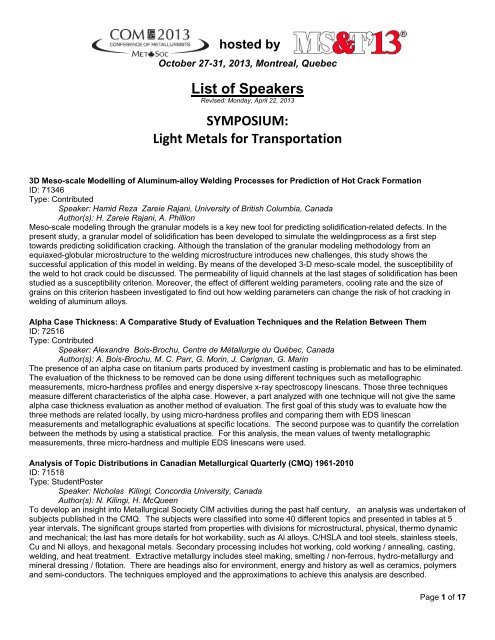

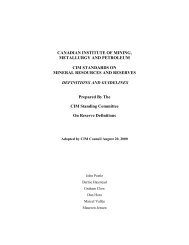
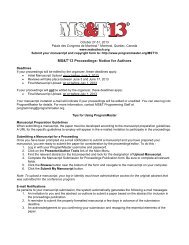


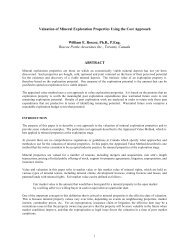
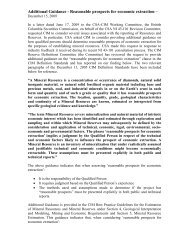
![Richard Wright - NORWEST Corporation [PDF]](https://img.yumpu.com/34320526/1/190x245/richard-wright-norwest-corporation-pdf.jpg?quality=85)
